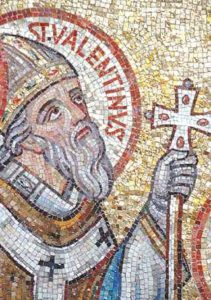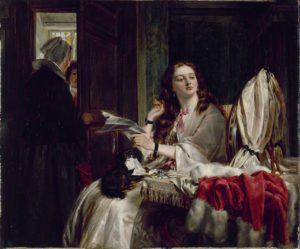14th February is well-known as a day of cards and flowers, hearts and candlelit meals, of toy cupids hovering with their dangerous arrows.
But did you know that this ultra-commercial modern festival has deep historical roots? Let’s take a look at how romance has played out on this day down the centuries.
In Roman times, there were several St Valentines, but two seem to have been the most famous: a bishop from Terni, Italy, and a priest from Rome.

Both were beheaded during the reign of the Emperor Claudius, but the legends of neither saint have anything to do with romantic love.
This association may have been made by later writers due to the fact the official days of these saints in the Church calendar fall near the start of spring, a time associated with both the reawakening of nature after winter and increased romantic urges in both the human and animal kingdoms. This has even led some people to claim that St Valentine is a Christian representation of an ancient fertility figure.
By the 14th century, the idea was current that St Valentine’s Day was the day when birds chose their mates. Geoffrey Chaucer, author of the Canterbury Tales, elaborated on this in his Parlement of the Foules, and the notion of romance among birds was mentioned by other writers of the time. But none of them linked St Valentine’s Day with romance between humans.


By the Fifteenth century, however, this connection had been made. Poems such as John Lydgate’s A Valentine to her that Excelleth All (1440) describe people choosing their loves on this day.
The notion of St Valentine’s being a day for human romance was thereafter celebrated by a number of poets and playwrights, including Shakespeare, Ben Johnson and John Donne, although many of them still emphasised the link with birds.
Romantic ideas are also found in letters from this period. A letter sent by one Dorothy Osbourne in 1654 states, “I’ll tell you something you don’t know, which is, that I am your Valentine and you are mine.”
The famous diarist Samuel Pepys mentions St Valentine’s Day 24 times between 1660 and 1669, but from his writings it seems the festival at that time was quite different to its modern descendant.
Though this day had the theme of romantic love, it appears that people’s ‘Valentines’ were often chosen by chance. At parties, people’s names were written on paper than drawn out of a hat. People were thus paired up and they played at being lovers. For the next few days, they paid one another compliments and bought presents. Even married people were expected to join in this game.
Another custom was that, rather than being chosen by lot, your Valentine was the first person of the opposite sex you happened to see on the morning of the 14th.
St Valentine’s was also seen as a day, along with Christmas and Halloween, upon which you could predict your future husband or wife. One superstition stated that if a girl threw hemp seed over her shoulder at midnight, she would see her future husband behind her.


Though it was common for people to exchange letters and verses on Valentine’s Day, the first commercial cards didn’t appear until the early 1800s. Such cards soon caught on and could range from simple affairs to elaborate and expensive extravaganzas featuring silk, lace and feathers.
In Victorian times, Valentine’s Day became less popular, perhaps in reaction to a custom that had grown up of using Valentine’s cards to send insulting verses rather than romantic ones.
One magazine in 1885 stated, “St Valentine’s Day attracts very little attention in England nowadays, but across the Atlantic the saint is still honoured.”
And it was due to the increasing American influence on British culture, along with enthusiastic promotions from card manufacturers, that St Valentine’s was revived after the Second World War. And the festival today is indeed a commercial love-in with brisk sales of chocolates, flowers, soft toys, romantic dinners and sexy underwear.


In 2013, it was estimated that Valentine’s Day caused Britons to spend almost £1 billion on cards, dinners and weekends away. Men spent than women, with the average male spending £39.57 and the average woman shelling out £22.64.
The most romantic place in the UK, spending-wise at least, was Sheffield, with an average Valentine’s outlay of £63.03 per man. The most popular gift bought by men was flowers and the most popular present purchased by women was chocolates.


























